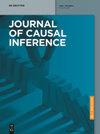最大熵的因果版本和不充分理性原理
IF 1.8
4区 医学
Q2 MATHEMATICS, INTERDISCIPLINARY APPLICATIONS
引用次数: 6
摘要
当没有理由使某一选择优于另一选择时,不充分理由原则(PIR)对随机实验的每一个选择都赋予相等的概率。最大熵原理(MaxEnt)将PIR推广到给出期望等统计信息的情况。众所周知,这两个原理都会导致因果联合分布的悖论概率更新。这是因为对条件P (effect∣cause) P\left({\rm{effect}}| {\rm{cause}})的约束导致P (cause) P\left({\rm{cause}})的变化,这些变化将更高的概率分配给那些为结果提供更多选项的原因值,表明“有意行为”。因此,早期的工作建议根据因果顺序依次最大化(条件)熵,但除了在玩具示例上的合理性之外,没有进一步的证明。我们通过将约束分离为对原因的限制和对从原因产生结果的机制的限制来证明PIR和MaxEnt的因果修改。我们进一步概述了为什么因果PIR也需要“信息几何因果推理”。我们简要讨论了将MaxEnt的因果版本推广到任意因果dag的问题。本文章由计算机程序翻译,如有差异,请以英文原文为准。
Causal versions of maximum entropy and principle of insufficient reason
Abstract The principle of insufficient reason (PIR) assigns equal probabilities to each alternative of a random experiment whenever there is no reason to prefer one over the other. The maximum entropy principle (MaxEnt) generalizes PIR to the case where statistical information like expectations are given. It is known that both principles result in paradoxical probability updates for joint distributions of cause and effect. This is because constraints on the conditional P ( effect ∣ cause ) P\left({\rm{effect}}| {\rm{cause}}) result in changes of P ( cause ) P\left({\rm{cause}}) that assign higher probability to those values of the cause that offer more options for the effect, suggesting “intentional behavior.” Earlier work therefore suggested sequentially maximizing (conditional) entropy according to the causal order, but without further justification apart from plausibility on toy examples. We justify causal modifications of PIR and MaxEnt by separating constraints into restrictions for the cause and restrictions for the mechanism that generates the effect from the cause. We further sketch why causal PIR also entails “Information Geometric Causal Inference.” We briefly discuss problems of generalizing the causal version of MaxEnt to arbitrary causal DAGs.
求助全文
通过发布文献求助,成功后即可免费获取论文全文。
去求助
来源期刊

Journal of Causal Inference
Decision Sciences-Statistics, Probability and Uncertainty
CiteScore
1.90
自引率
14.30%
发文量
15
审稿时长
86 weeks
期刊介绍:
Journal of Causal Inference (JCI) publishes papers on theoretical and applied causal research across the range of academic disciplines that use quantitative tools to study causality.
 求助内容:
求助内容: 应助结果提醒方式:
应助结果提醒方式:


